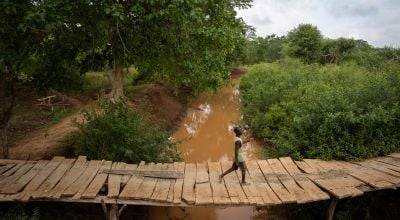
Read our 2023 annual report

Knowledge Hub
As the climate emergency deepens, more than 70% of the global workforce – 2.4 billion people – are now vulnerable to extreme heat events, which have become more frequent, more intense, and more deadly.
The effect on the world’s poorest societies is comprehensive: Markets empty, work stops, schools close, and hospital waiting rooms fill.
While all aspects of society are affected, the impact is not felt evenly. Women (and in particular, pregnant women), children, the elderly, outdoor labourers, and low-income communities suffer most.
After more than a decade of working with communities to measure and increase their resilience to flooding, the Zurich Climate Resilience Alliance (of which Concern Worldwide is a member) is expanding its scope to include other climate hazards, such as extreme heat and wildfires.
The Zurich Climate Resilience Alliance, powered by the Z Zurich Foundation, focuses on enhancing resilience to climate hazards in both rural and urban communities. Concern will be supporting communities in Bangladesh, Kenya, Malawi, and Pakistan in their efforts to adapt to extreme heat and flooding.
Read more about our partnership with the Alliance here.
How does it feel?
Public support for our work is dependent on public understanding, but few Irish people have experienced extreme heat. Our temperate climate has informed our understanding that “we’re not built for this heat”, but other people are. With this film, Concern dispels this notion. The audience learns how extreme heat feels, both on the body and the mind. The impact of extreme heat on the individual is analogous to the impact of extreme heat on society: slowing, warping, and damaging.
Watch below:
On 16th of September 2024, five Irish actors arrived at the Barefoot Hot Yoga Studio in Lucan, Co. Dublin. Although skilled in the performing arts, their responses to extreme heat were no simulation: The set was heated to between 45°C and 50°C.
"Irish people do not concern themselves with extreme heat," says Director Jon Hozier-Byrne, "but for communities all over the world, it's a frightening reality. With this film, we wanted to play on the old Irish conversational trope of 'not being built for this heat', that you hear parroted every time the sun breaks temporarily through the clouds. We wanted to expose Irish people to what extreme heat really feels like, the claustrophobia of it, the oppression of it. You can hear about a 51°C in Mecca and it all feels very abstract, but to see a range of Irish heads actually experience that heat, hopefully gives it a sense of tangibility, of immediacy."

The temperatures experienced by the cast and crew matched the temperatures described in an audio track, played live while the actors sat. The audio track, which formed the soundtrack of the film, features the voices of Concern staff, news commentators, experts, and ordinary people describing their experiences of extreme heat.
One of those voices was Ibrahim, who recorded his testimony in the Kurdistan region of Iraq:
"When it's 40°C or 45°C, it's crazy. I get angry very quickly, I feel like my body is boiling. I postpone my duties, my tasks, everything until evening. You need to change your clothes every two hours. People, they run away from the cities."

"All credit to the cast and crew," says Jon, "who survived significantly longer in the heat than our cameras. The whole team worked in extreme temperatures for six hours or so, all trying to create a sense of synesthesia - trying to replicate the experience of one sense with another. Niall, our editor, did an incredible job of portraying the sense of panic implicit to the experience of extreme heat."

The work of Concern and the Alliance in the area of extreme heat is only just beginning. Look out for updates and stories on this website and across our social media platforms. In the meantime, read more about extreme heat and the work of the Alliance in the links below.






